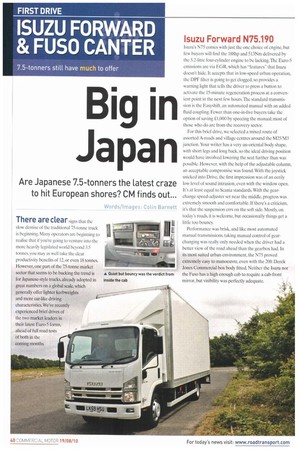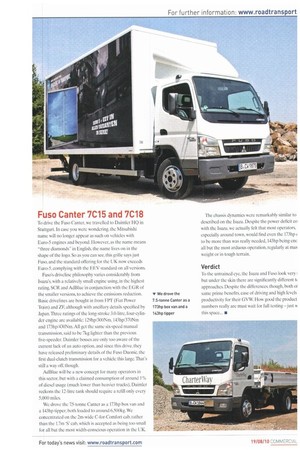Big in Japan
Page 40

Page 41

If you've noticed an error in this article please click here to report it so we can fix it.
Are Japanese 7.5-tonners the latest craze to hit European shores? CM finds out...
Words/Images: Lutin bdi nett There are clear sig,ns that the slow demise of the traditional 7.5-tonne truck is beginning. Many operators are beginning to realise that if you're going to venture into the more heavily legislated world beyond 3.5 tonnes. you may as well take the clear productivity benefits of 12, or even 18 tonnes. However, one part of the 75-tonne market sector that seems to be bucking the trend is A Quiet but bouncy was the verdict from for Japanese-style trucks, already adopted in inside the cab
great numbers on a global scale, which generally offer lighter kerbweights and more car-like driving characteristics. We've recently experienced brief drives of the two market leaders in their latest Euro-5 forms. ahead of full road tests of both in the coming months.
Isuzu Forward N75.190
Isuzu's N75 comes with just the one choice of engine. but few buyers will find the 188hp and 513Nm delivered by the 5.2-litre four-cylinder engine lobe lacking. The Euro-5 emissions are via EGR, which has "teaturesthat Isuzu doesn't hide. It accepts that in low-speed urban operation, the DPF filter is going to get clogged, so provides a warning light that tells the driver to press a button to activate the 15-minute regeneration process at a convenient point in the next few hours.The standard transmission is the Easyshift, an automated manual with an added fluid coupling. Fewer than one-in-five buyers take the option of saving £1.000 by speccing the manual:most of those who do are from the recovery sector.
For this brief drive, we selected a mixed route of assorted A-roads and village centres around the M25/M3 junction. Your writer has a very un-oriental body shape, with short legs and long back, so the ideal driving position would have involved lowering the seat further than was possible. However, with the help of the adjustable column, an acceptable compromise was found. With the joystick snicked into Drive. the first impression was of an eerily low level of sound intrusion, even with the window open. It's at least equal to Scania standards With the gearchange speed-adjuster set near the middle, progress was extremely smooth and comfortable. If there's a criticism, it's that the suspension errs on the soft side. Mostly, on today's roads, it is welcome, but occasionally things get a little too bouncy.
Performance was brisk, and like most automated manual transmissions, taking manual control of gearchanging was really only needed when the driver had a better view of the road ahead than the gearbox had. In its most suited urban environment, the N75 proved extremely easy to manoeuvre, even with the 20ft Derek Jones Commercial box body fitted. Neither the Isuzu nor the Fuso has a high enough cab to require a cab-front mirror, but visibility was perfectly adequate.
Fuso Canter 7C15 and 7C18
To drive the Fuso Canter. we travelled to Daimler HQ in Stuttgart. In case you were wondering. the Mitsubishi name will no longer appear as such on vehicles with Euro-5 engines and beyond. However, as the name means "three diamonds" in English, the name lives on in the shape of the logo. So as you can see, this grille says just Fuso, and the standard offering for the UK now exceeds Euro-5, complying with the EEV standard on all versions.
Fuso's driveline philosophy varies considerably from Isuzu's, with a relatively small engine using, in the highest rating. SCR and AdBlue in conjunction with the ECiR of the smaller versions, to achieve the emissions reduction. Basic drivelines are bought in from FPT (Fiat Power Train) and ZF, although with ancillary details specified by Japan. Three ratings of the long-stroke 3.0-litre, four-cylinder engine are available: 129hpf300Nm,143hp/370Nm and 173hp/430Nm. All get the same six-speed manual transmission, said to be 7kg lighter than the previous five-speeder. Daimler bosses are only too aware of the current lack of an auto option. and since this drive, they have released preliminary details of the Fuso Duonic, the first dual-clutch transmission for a vehicle this large. That's still a way off though.
AdBlue will be a new concept for many operators in this sector, but with a claimed consumption of around 1% of diesel usage (much lower than heavier trucks). Daimler reckons the 12-litre tank should require a refill only every 5,000 miles.
We drove the 7.5-tonne Canter as a 173hp box van and a 143hp tipper, both loaded to around 6500kg. We concentrated on the 2m-wide C-for-Comfort cab. rather than the 1.7m 'S' cab, which is accepted as being too small for all but the most width-conscious operation in the UK. The chassis dynamics were remarkably similar to described on the Isuzu. Despite the power deficit co with the Isuzu. we actually felt that most operators. especially around town, would find even the 173hp ( to be more than was really needed, 143hp being ene all but the most arduous operation. regularly at ma weight or in tough terrain.
Verdict
To the untrained cyc, the Isuzu and Fuso look very hut under the skin there are significantly different u approaches Despite the differences, though, both 01 same prime benefits, ease of driving and high levels productivity for their GVW. How good the product numbers really are must wait for full testing—just NI this space... •




























































































































